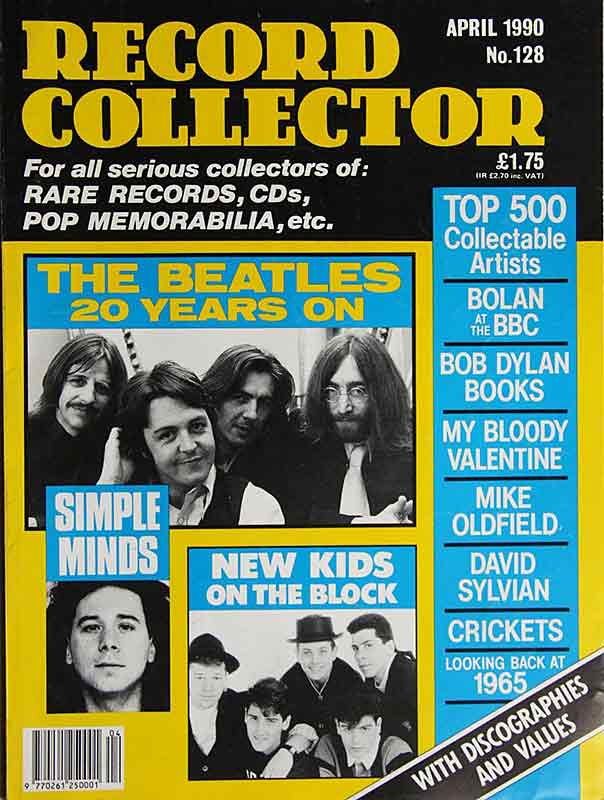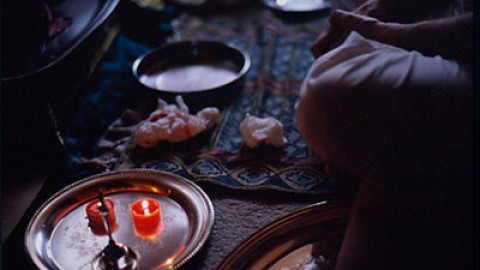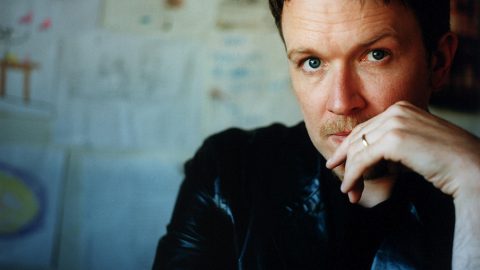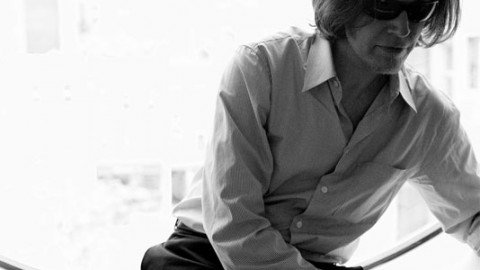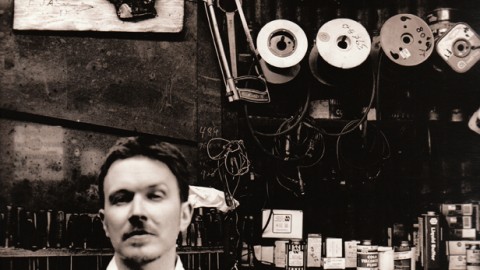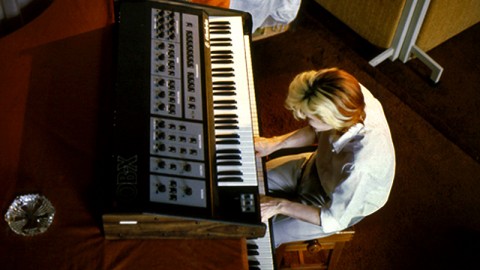by Mark Prendergast
Originally published in two parts; Record Collector April and May 1990.
The story of David Sylvian is an odd one in the annals of British pop music. Having risen to stardom in company of New Romantic icons Duran Duran and Ultravox, Sylvian’s group Japan represented all that was ludicrous about the early 80s. Taking the long-haired, effeminate image of the New York Dolls and mixing it with the art-pop of early Roxy Music, Japan sparkled like a tropical cocktail. Most critics dismissed them as a superficial bunch of South London poseurs whose career would nose-dive abruptly. And by 1983 they were right. The 1981 album, “Tin Drum”, where intricate Oriental arrangements neatly complemented Sylvian’s growing vocal finesse, remains the band’s finest legacy.
Since then, the singer has virtually reinvented himself .Through a series of solo recordings he has not only created music that is polished, sophisticated and heartfelt, but which has also broken with past pop tradition. By experimenting with instrumental, jazz and ethnic stylisations, Sylvian has become a focal-point for all that is good about ‘new music’. He’s acquired a reputation as a difficult interviewee, prone to abstract theorising and guarded responses, but having spoken to him at length on two occasions, in 1987 and again in 1989, the musician I met was open, friendly, enthusiastic and very honest.
INTROSPECTIVE
Sylvian was born David Batt on 23 February 1958, in Beckenham, Kent. He grew up in a working-class family in South London, first in Crystal Palace, and then in Lewisham. A highly introspective individual, Sylvian found solace in painting and music while at school, later investing in a guitar, as did his brother Steve (later Steve Jansen). Together with Richard Barbieri and Mick Karn, they formed Japan.
Totally distracted from his O-levels, Sylvian remembers it being “a means of getting away from our environment, of making money and sticking together as friends”. Things were pretty tough until the appearance of Simon Napier-Bell, one time manager of the Yardbirds and Marc Bolan, and future creators of Wham! Nalpier-Bell had come out of semi-retirement in 1976 and was searching for new talent. He heard about Japan, was taken with Sylvian’s self-possession and the androgynous image, ignored the fact that they could barely play their instruments, and took the plunge. By concentrating on the Japanese market and the photographic aspect of the group, he turned Japan from hopefuls into stars in the space of two years. Their debut album, ” Adolescent Sex” (Ariola, 1978), sold 30,000 copies, and after much media exposure, high chart placings and sell-out tours were theirs for the asking.
In retrospect, the presentation of the group as pop poseurs obscured their maturing musicality. On 1980’s “Gentlemen Take Polaroids”, Sylvian’s svelte vocals and Karn’s supple bass work knitted perfectly with Barbieri’s exotic keyboard playing and Jansen’s feather-touch drumming. Aided by Ryuichi Sakamoto, the classically trained pianist and founder of Yellow Magic Orchestra, Sylvian slowly taught himself the intricacies of Japanese music; and for the best-selling “Tin Drum”, he drew upon “the sparsity of traditional Japanese music for the slower pieces in that the emphasis was as much on space as it was on the notes in the arrangements”. He even credits German electronic pioneer Karl-Heinz Stockhausen for inspiring “the abstract synthesiser lines on ‘Ghosts’ “. Given this kind of openness and flexibility, it’s not surprising that Sylvian outgrew Japan’s restrictive pop brief, and after a serious rift developed between himself and Mick Karn, the group folded.
The seeds were sown for a future solo career when Sakamoto invited the groupless singer to Tokyo near the end of 1982. The composer was working on the sound track to the “Merry Christmas Mr. Lawrence” film starring David Bowie, and wanted a contribution from Sylvian. The result was the sublime vocal piece, “Forbidden Colours”. Just two days were spent in Onkio Haus studios,but the experience restored the singer’s confidence. Issued as a single in June 1983, it proved more successful than the pair’s previous collaboration, “Bamboo Houses”, achieving a No.16 chart place. Spurred by this success, Sylvian began to write new material to incorporate a wide canvas of musicians and genres.
His first solo album, “Brilliant Trees”, recorded in Berlin and London in the winter of 1983/84, was extremely well-recieved and a far cry from his work with Japan. Not wishing to be restricted by his own limited guitar, percussion and keyboard skills, Sylvian invited a broadly experienced group of musicians together to assist him: trumpeter Jon Hassell gave the record a strong Eastern flavour flavour; Holger Czukay, a founder member of German group Can, added incidental voices taped from short-wave radios; while the twang of Danny Thompson’s up-right bass was included simply because Sylvian liked the feel of his sound on old John Martyn and Nick Drake records. Other instrumentalists included ex-Van Morrison side-man Kenny Wheeler, and old hands Sakamoto, Barbieri and Jansen, Steve Nye’s spatial production added the final touch to an unusual and consummate solo debut.
Sylvian recalls: “I chose the musicians on the basis of what they could add to compositions I had written at home. They all played roles which I had intended for them from the outset. Those sections where Jon is playing trumpet were actually written before I’d even contacted him about the record. Both lyrics and tunes were sketched out on a four-track tape machine, with the help of rudimentary percussion, synth and guitar. Then I brought the musicians into the studio and dealt with them on a one-to-one basis just talking the ideas through. Holger was invited so that there was someone there to bounce ideas off. On that record, I was interested in creating a sense of space, a sort of unspecified aural landscape.”
AMBIENT
This final point sent the milld spinning back to Brian Eno and his concept of ambient music, Certainly Japan were fans of early Roxy Music and had even engaged ex-Roxy producer John Punter on 1979’s “Quiet Life” LP, “Yes,” confirmed Sylvian, “Brian Eno was a musical influence on Japan’s career, particularly from the stand” point of sound structure. I’ve constantly been interested in his work and was very taken with his adapting of the studio as an instrument in its own right. Since today’s technology is so flexible his ideas are even more relevant now.”
Three singles, “Red Guitar”, “The Ink In The Well” and “Pulling Punches” were pulled from the album, charting at 17, 36 and 56 respectively. There were picture disc and poster sleeve editions, but most sought after seems to be the fold-out sleeve issue of “The Ink In The Well, now valued at 7.
Boosted by the success of “Brilliant Trees”, Sylvian returned to Tokyo in late 1984 to work with Seigen Ono and Ryuichi Sakamoto again. This time, instrumental music was on the cards. An African-sounding tape experiment titled “Preparations For A Journey” was recorded quickly with Ono. Then he spent eight days with Sakamoto working on “Steel Cathedrals”, a lengthy sound track for a video film about Tokyo by a man called Yamaguchi. A strong tom-tom slap-rhythm anchored a pulsating, drifting composition that involved a lot of vague background city noises. Back in London, Sylvian got guitarist Robert Fripp to add some grinding electric lead while Kenny Wheeler handled the horn breaks. Even Holger Czukay was brought in to splice up the track with some strange short-wave radio recordings, small segments of voice and music dropped in here and there to give it flavour. Czukay also assisted on “Words With The Shaman”, a Sylvian/Hassell collaboration that conjured up visions of the Sahara and Arabia. Some of it was issued as a 12″ EP during November 1985; all of it finally appeared as a limited edition, numbered cassette titled ” Alchemy – An Index Of Possibilities”. More recently, this has been granted a CD release.
LAYERS
David recalls: “I was aiming for something between pop music and avant-garde music. My approach was to build up layers and layers of sound until something was working for me emotionally. I’m interested in unease in music, and instrumentals, if they are to work, must convey a sense of fascination. New Age music, to my mind, is a marketing term for record companies and an uncreative solution by musicians to the problems of making interesting instrumental music. On’ Alchemy’, I allowed the players to do what they wished and shifted things around quite a bit in the studio at the editing stage so as to facilitate that.”
On a creative roll, Sylvian pushed on, his growing self-confidence etched out for all to hear in the grooves of his grand double-album extravaganza “Gone To Earth”, released in August 1986. Co-produced and engineered by old friend Steve Nye at the Town House, London, and the Manor, Oxfordshire, the package consisted of one very strong lyrical rock album, and an accompanying instrumental disc. The vocal sides were the toughest and featured some quite blistering guitar-work by ex-progressive rockers Bill Nelson and Robert Fripp, particularly on “Before The Bullfight” and “Wave”. Once again, Sylvian went for interesting arrangements, and musicians such as Phil Palmer (acoustic guitar), Mel Collins, (soprano sax) and Kenny Wheeler (flugel horn) added spice to the proceedings.
Lyrically, Sylvian’s songs were familiary emotive and highly personal. Songs of longing, loving and searching were refracted through painterly images of trees, lakes, skies and mountains. Yet, because the singer’s voice was so smooth, the words seemed to drift in and out of the music like another instrument. Both the jazz ballad “Laughter And Forgetting” and the upbeat pop song, “Silver Moon”, were good examples of this vocal fluency. Strangely enough, the title track was at variance with the other material in that it consisted of a strained rough vocal, sung over a jagged Robert Fripp guitar solo.
Sylvian recalled: “The lyrics for the song ‘Gone To Earth’ were written before I got in the studio. I had in mind to do two versions:. one with Bill Nelson and another with Robert Fripp, but in the end I only had time to record the one with Robert. I sat down with him in the studio, picked out the song on guitar, and he responded immediately by playing something very aggressive. I recorded the rhythm track there and then and very quickly he came up with two or three takes on lead guitar that would be suitable. The vocal went down soon after, and in all, it was a very spontaneously created song with the minimum of studio overdubbing.”
STRANGE
Another reason why this song was so strange was because Sylvian utilised a voice segment of a man named J.G. Bennett. Here, behind the stormy guitar chords, could be heard the dignified words of an old man talking about his soul entering the divine world. In fact Fripp had often used Bennett’s voice on his own records and had once studied practical philosophy with him. Bennett was a disciple of the Armenian mystic Gurdjieff and had passed on a philosophy of enlightenment through discipline and work” to Fripp. Sylvian was keen to learn as much as possible and soon acquainted himself with Bennett’s teachings.
The tranquil instrumental record of the “Gone To Earth” set evinced a growing spiritual awareness, and such titles as “The Healing Place”, “Answered Prayers” and “The Wooden Cross” had strong Christian associations. Even occasional murmurings on the meaning of life and death by German artist Joseph Beuys were included for effect. Journalists criticised Sylvian’s efforts as pompous and pretentious without really trying to get to grips with the artist’s psyche. Simply, Sylvian was giving himself a self-education and using certain writers, artists and philosophers as reference points.
He told me: “Most of the things I read are rather factual books on various forms of religious belief from Buddhism to Christianity to the Jewish Kabbula, and even certain kinds of magic like Rosicrucianism. Just an assortment of things, really, that throw more light on my own experience. Through the music, it is possible for me to show an appreciation of life and nature, but I don’t think one should preach. My work is primarily based on my own feelings and experiences and not intellectual understanding. For me the latter is a secondary thing.”
Next month, we shall assess subsequent developments in Sylvian’s career, climaxing with the recent re-packaging of his entire solo output into one lavish boxed CD retrospective, “Weatherbox”.
We ended last month’s look at the solo career of ex-Japan vocalist David Sylvian with the release of the ambitious “Gone To Earth” double album set in August 1986. Part two traces the singer’s career from this, perhaps his most accomplished work to date, to the present time when rumours of a reunion with other ex-Japan members and a project with the legendary Scott Walker abound.
Two singles were lifted from “Gone To Earth”, “Taking The Veil” and “Silver Moon”. A 7″ square picture disc for the former, and a limited fold-out sleeve edition for “Silver Moon” are both desired items for Sylvian collectors.
During 1986, David had embarked upon a world press tour to promote “Gone To Earth”. Wearing shoulder-length brown hair , tinted spectacles and low-key designer clothes, his image was the antithesis of the peroxide blond days of Japan. Accompanied by his Japanese girlfriend and constant companion and adviser Yuka Fujii, he even went as far as Australia and the Orient to enthuse about his work. Sylvian had often praised Yuka publicly for her artistic advice and was now listening avidly to the ECM jazz catalogue at her suggestion. A new LP was taking shape in his mind, one which emphasised compact songwriting alongside simple acoustic instrumentation.
Back in England, Sylvian spent the first couple of months of 1987 making rudimentary home demo tapes of songs that would draw on the subtler sides of jazz, folk and orchestral musics. Recorded in just 2.5 months in studios in Holland, France and Bath, “Secrets Of The Beehive” appeared in October 1987 to universally positive reviews. Gone was the dense, rockist sound of the vocal “Gone To Earth” set, and in its place was a pastoral softness that suffused Sylvian’s observations of life, love and doubt with a crystalline sheen. Both Ryuichi Sakamoto and Brian Gascoigne did some fine string and brass arrangements on “Orpheus” and “Let The Happiness In” respectively. Each and every song had its own alluring quality, and contributors like Danny Thompson (double bass), Mark Isham (trumpet/flugelhorn), David Torn (electric guitar) and Phil Palmer (acoustic guitar) made telling contributions. Sakamoto, in particular, must be credited for providing excuisitely complementary synth and keyboard motifs.
EASILY
“The emphasis here,” David told me, “was on the lyrical content more than on previous albums. Because the material came to me so easily and had a certain strength in its simplicity, I felt it didn’t require enhancing in terms of studio atmospherics and effects. I began recording the basic tracks at Chateua Miraval in the South of France because of its exotic location. Like when I started ‘Brilliant Trees’ in Berlin, the idea was to create a looseness among the musicians involved because everybody’s meeting in a strange place for the first time. It just opens up people a bit more.
“David Torn, Danny Thompson, Ryuichi, and percussionist Danny Cummings came down and we built up ihe tracks one by one. Then when all the basic stuff was down I came back to London with Ryuichi to do the orchestral arrangements at Angel studios. Then it was off to Wisseloord in Holland to finish the overdubs and do vocals. Final additions and mixing were done at the Wool Hall in Bath with Steve Nye, who’s very much into acoustic music as well as electronic music. With the orchestral ideas I had in mind, I knew Steve would be more than adequate for the job. Nowadays, a lot of engineers have no understanding of how to mike an orchestra, or acoustic instruments for that matter. But Steve has a fantastic knowledge, and because of the nature of the arrangements on ‘Secrets Of The Beehive’, I could trust him to produce and engineer it to my satisfaction.”
Sylvian had often spoke about his dislike of digital processing, and though the production sound of “Secrets Of The Beehive” was pristine, it was all analogue-based, mastered with Dolby SR noise reduction. Having met Holger Czukay in 1983, Sylvian was struck by his ability to deteriorate sound quality and make it, with other extraneous material such as excessive hiss and bits of radio and voice recordings, an integral part of a composition. Now in his fifties, Czukay’s idiosyncratic methods derived from years of study with Karl-Heinz Stockhausen (the first serious composer to work with electronics), and his even lengthier stint with German progressive rock band Can.
In the late 1960’s, Czukay had recorded an experimental album of taped sound collages, mixing various field recordings with electronic tones, titled “Canaxis 5”, but digressed from this to play bass with Can. Near the end of 1986, Sylvian flew to Cologne to record a vocal for a Czukay solo album, and unexpectedly pushed the experimentalist down the sound collage avenue again. Over three nights, the pair dabbled with pianos, guitars, vibraphones, synths, organs and various radio samples from around the world at Czukay’s converted cinema studio. A Journalist named Karl Lippergaus and ex-Can drummer Jaki Liebezeit were also in attendance.
Due to editing problems and contractual difficulties, it took another 18 months for the resulting album, “Plight And Premonition”, to be released. Consisting of two lengthy atmospheric pieces, this album was light years away from conventional rock or pop music. No riffs, guitar breaks, middle-eights or songs were to be heard, just the ambient wash of spiralling tones punctuated by radio and morse code interference. Avant- garde and brilliantly original it was, but a critical success it certainly was not. Sylvian was pummelled by the rock press, but the fans still went out and bought it, taking the album into the lower regions of the chart.
COLOGNE
Sylvian recalls, “It was the easiest record I’d ever made and quite unexpected. I arrived in Cologne one evening to do some work on Holger’s ‘Rome Remains Rome’ album. It was late so we went out to dinner with a friend of Holger’s, Karl Lippergaus. Then we went back to the abandoned cinema where Holger has his studio and started dabbling. You see, the studio has quite a large work-space with no separation between playing area and control room. Karl just sat down at a piano and played a little melody. I joined him on electric guitar , and after a while, began making some repeating tape-loops. Holger added occasional excerpts from short-wave radio and we just went on all night, recording this free improvisation. The idea was to create environmental atmospherics. ‘Premonition’ was basically one performance but ‘Plight’, which was originally only ten minutes long, was re-edited extensively by Holger in 1987. He really brought that to life; it’s really his piece. ‘Premonition’ was closer to me.”
Having spent years creating ideas in studios and in his own head, Sylvian decided that 1988 was the year to go public once again. Assembling a band that included old Japan cohorts Steve Jansen (drums) and Richard Barbieri (keyboards), Sylvian also recruited Mark Isham (trumpet/flugelhorn), lan Maidrnan (bass) and experimental ECM- signed guitarist David Torn. Travelling under the banner ‘In Praise Of Shamens’, an 80-day world tour was undertaken. Expanded versions of album tracks were performed in cities ranging across Europe, the Far East, and America. Improvisation was the order of the day and every night produced something unexpected. Sylvian’s interest in jazz was never more pronounced: Mark Isham compared the music to that of Wayne Shorter and Joe Zawinul in Weather Report, “where the solos are part of the fabric of the piece”. David Torn commented: “I think Sylvian’s got some kind of Miles Davis’s sense for assembling really interesting, even provocative, constellations of musicians and he really knows how to get the best playing out of them.”
“I really enjoyed that tour,” says David, “We were very well received, especially in America and Italy. In Japan, I remember the audiences were less emotional, less expressive and possibly bewildered by the choice of material and its presentation. The performances were quite intense, two hours a night, and we chose to improvise on the longer pieces, the heavyweight stuff like ‘Steel Cathedrals’ and ‘Words With The Shamen’, for example. We only played seated venues, and though the work was very demanding, it was great to see those musicians playing live together and getting so much out of it. For myself, I found the mental exhaustion far more difficult to deal with than the physical. I was there at the end of every decision with my manager Richard Chadwick, and every problem that came up had to be dealt with personally , and that was extremely exhausting. Still, it was worth it.”
CRITICS
Having finished the tour in June 1988 and become a hit with the critics again as a result, David Sylvian temporarily retired from music making. Resting at his London home, he spent many months improving his playing technique on guitar and keyboards. After five months of comparative inactivity, he understandably felt frustrated, and was happy to visit Holger Czukay in Cologne for a 14-day creative Christmas break. Sparks began to fly as the duo teamed up in the studios again, and with the help of ex-Can musicians Jaki Liebezeit (percussion) and Michael Karoli (guitar). Almost a Can reunion, “Flux And Mutability” was released by Virgin Venture in September 1989.
David Sylvian: “I went over to see Holger at a point when I needed something to motivate me into creativity again. My intention from the outset was to record an album, whereas with ‘Plight And Premonition’, it was a spontaneous happening. Therefore, the second time, the atmosphere was slightly different, but the approach and techniques were the same. We sat down and started to create an aural environment or atmosphere. We began with ‘Mutability’, which was very easy to record; so easy it was incredible. A series of first takes, a couple of keyboard overdubs, four guitar overdubs, and it was finished in one day! ‘Flux’ was more complicated and in fact wasn’t an easy piece to get right. The basic track was me, Michael Karoli (guitars), plus Markus Stockhausen (flugelhorn), a rhythmic ambient instrumental titled “Flux” was recorded.
More perceptibly dynamic than either “Plight” or “Premonition”, “Flux” was pushed healthily along by Czukay’s strong bass work and Leibezeit’s African oriented drum beats. Sylvian filled out the textures, and as a matter of course, the incidental sounds of radio-derived segments and out-door noises such as those made by rattling trains were also in evidence. A second track. “Mutability”, was contrastingly simple with just Sylvian’s poignant electric guitar being heard against a backdrop of electronic sound and African flute played by Jaki Liebezeit.
Holger and Jaki, and again a first take. Holger was happy with it, especially with Jaki’s percussion, but I wanted to push it further. The more we worked on it, the less ambient it became; and thus we had to rethink the original ideas which had resulted in ‘Plight’, ‘Premonition’ and ‘Mutability’. We worked on ‘Flux’ an awful lot. Both Michael Karoli’s aggressive, razor’s edge guitar, and Markus Stockhausen’s flugelhorn were put on afterwards, and they helped finish the track.”
SKILL
By this stage, Sylvian had established himself as a composer of consummate skill and intelligence who wasn’t afraid to experiment. An aesthetic musical arranger and producer, Sylvian’s own solo output had a classical quality that defied mere pop music definitions. Lyrically, his words were compared to those of the nature poets of the Romantic era. Fittingly, in November 1989, Virgin repackaged all his solo recordings into one sumptious CD boxed set entitled “Weatherbox”. Imbued with the character of an 18th century artefact by artist/designer Russell Mills, “Weatherbox” also contained two new instrumentals, “A Brief Conversation” and ” Kin”. Both were fairly avant-garde in nature and were added to the original “Alchemy” recording to form a full-length CD. Simultaneously, Sylvian released a quirky vocal single called “Pop Song”, a strange amalgam of Japan-like music with lyrics which subversively criticised the superficiality of radio pop music.
The singer says: ” ‘Pop Song’ was a one- off. Musically, I was experimenting there with tonalities, tunings and quarter-tones in the programming of synthesisers. That’s why it sounds so weird. Originally, it was just an improvisation on tape, but because of the strange tunings, it sounded interestingly different for me to bring it to the studio and put a vocal on it. ‘Pop Song’ is really just me working with synthetic sound again after years of playing acoustic instruments.”
Nowadays, David Sylvian strikes one as a well-travelled, refined gentleman. His accent has the lilt of English middle-class education. He constantly smokes Gauloises and speaks quietly, choosing his words carefully. His interests range across art, photography, quality cinema and painting. Sitting amidst the quaint Edwardian blue decor of a Holland Park hotel-room, this man seems happy with his new life. Certainly, he’s come a long way since those gaudy, early Japan days where music played second fiddle to image and a few thousand scuffling fans at the Lyceum was the climax of a working year. Surprisingly, though, Sylvian’s parting shot promises a new lease of life for his old band.
“The next thing I want to do,” he says, “is a group project with all the ex-members of Japan. We’ll be going into the sudio to improvise a new record together. We haven’t played as a unit since Japan split up and there won’t be any rehearsals. It’s just into the studio and improvising and recording from day one. We’ll just see what happens. l have an idea it won’t be like our past work, but very different, probably more experimental.” The fruits of this new project should see the light of day sometime later this year.

